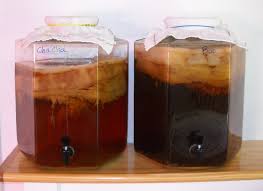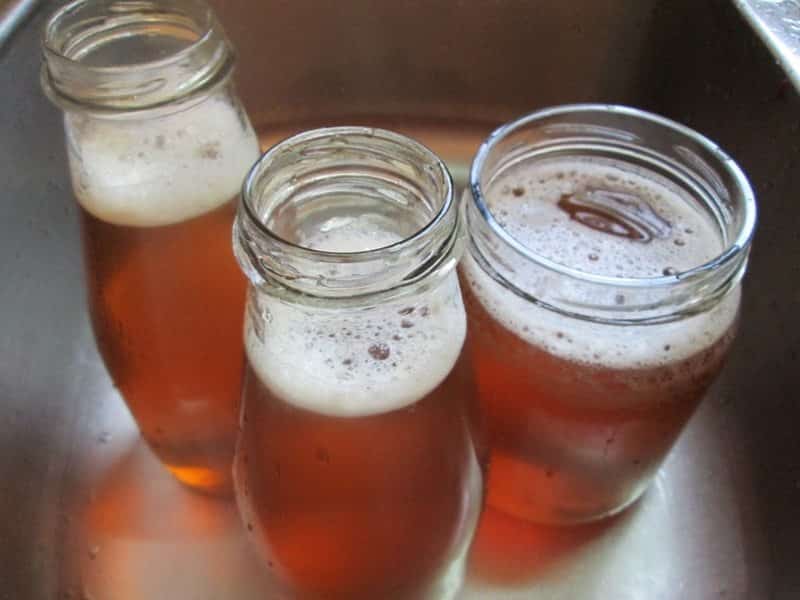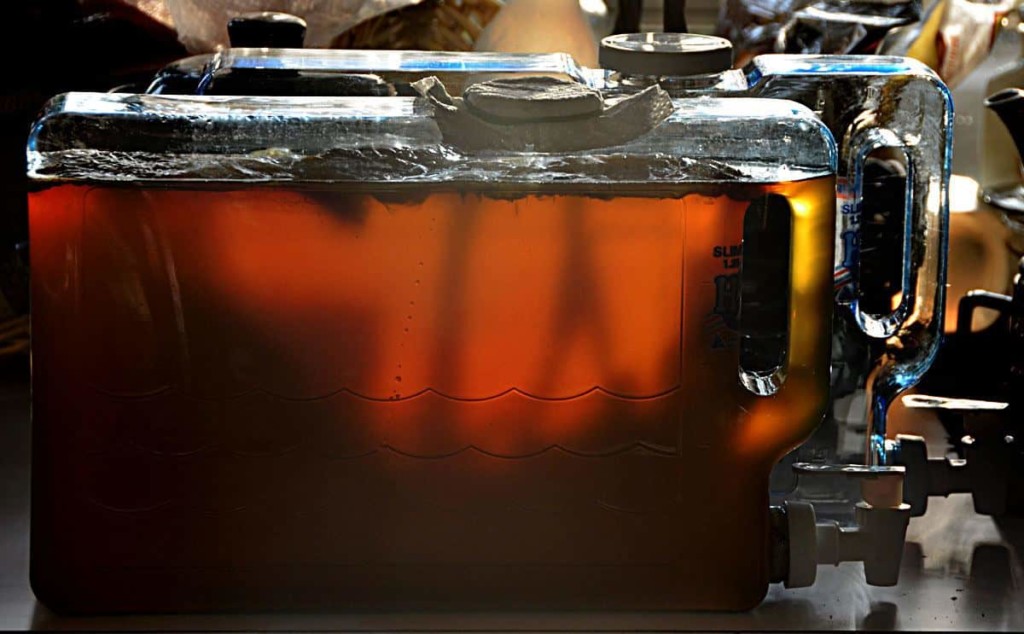Continuous Brew vs. Single Brew System: Pros And Cons
All kombucha is made in essentially the same way. You put a SCOBY (Symbiotic Colony Of Bacteria and Yeast) in a mixture of brewed tea (the leaves of the Camellia sinensis plant are the best choice of tea for making good kombucha consistently) and sweetener and give the microorganisms enough time to ferment the nutrients and sugars in the sweet tea mixture, during which they produce the probiotics, vitamins, and essential organic acids that create the many health benefits of kombucha.
Within that simple process, however, you can make many different choices, all of which will affect the way you brew the kombucha tea, the flavor and quality of the tea, and the long-term health of your SCOBY. One of the main choices that many brewers face is whether to choose single-batch brewing or set up a continuous brewing system. There are good reasons to do both of them, depending on your own personal tastes and situation. In this article, you’ll get the pros and cons of batch brewing and continuous brewing, and be able to make your own decision.
The Two-Sentence Explanation
A continuous brew system uses one brewing container containing a permanent SCOBY resident that you feed with a constant supply of fresh sweet tea so that the brewing cycle never ends.
The single brew system uses one or more containers that you add the SCOBY and sweet tea mixture to, and both SCOBY and liquid are removed from the container(s) at the end of the brewing cycle.
Health Benefits
You can look at the health benefits of kombucha from two sides: negative and positive. Yes, “negative health benefits” is somewhat of an oxymoron, but in this case you’re talking about some of the things that can make kombucha dangerous to drink like contamination from mold or toxic bacteria. It doesn’t happen often, but it’s something you need to keep in mind.
Continuous Brew
Fermented beverages have been around for centuries, and the history of kombucha goes back many generations in Eastern Europe and Asia. Many traditional brewers in these regions have always used a continuous brew system, keeping a jar of fermenting tea ready to drink just like they keep their sourdough starter ready to use in a warm place, refreshing it with new “food” to keep the yeasts and cultures strong and healthy.
Studies analyzing the nutritional content of kombucha during primary fermentation – the period of time during which the SCOBY is in the liquid mixture and the process is aerobic (using oxygen) – show that there is a definite increase in the amount of nutrients and organic acids in the brew the longer the fermentation continues. Because the SCOBY stays in the tea mixture, there is a continuous production of these probiotic and anti-oxidant compounds. What’s more, many of the more complex nutrients do not begin to develop until the fermentation of the sweet tea has been going on for more than two or three weeks, so letting the SCOBY actively continue transforming the tea mixture over a long period of time gives you a significant boost in health benefits.
The disadvantage of using a continuous brewing system is that it can be harder to monitor the health of your SCOBY and check for odd colors that may indicate mold, especially if you use an opaque container. Since you’re not removing the SCOBY and examining it after every batch, you might miss the signs of a problem.
However, if you keep a good balance between the acidic fermented tea in the container and the sweetened tea that you add regularly so that the pH stays at or below 3.2, you’re increasing the resistance of the brew and the SCOBY against mold and invasive bacteria.
Single-Batch Brew
On the other hand, since you’re not moving the SCOBY in and out during continuous brewing, but instead keeping it in a covered container that should protect it from mold and other contaminants, you’re also reducing the risk that there will be a problem, because the SCOBY is not exposed as often as it would be in single-batch brewing. However, since you’re examining the SCOBY after each single batch, you have a better chance of catching any problems before they create a health hazard (for you or for your SCOBYs).
In addition, single-batch brewing generally can’t go on as long as necessary to get the most development of organic acids and other compounds. The yeasts will eventually run out of sugar in the sweet tea mixture, and the kombucha tea will get more and more sour until it is too acidic to drink. The organic acids are there, but it’s difficult to take advantage of them when the kombucha is more sour than vinegar.
Quality and Quantity
The choice between continuous brew and single batch brew will also depend on how much kombucha you drink daily and weekly, whether you like plain or flavored kombucha, and how often you drink it.
Single-Batch Brew
If you only drink kombucha tea occasionally, then you may find it more convenient to make a batch of kombucha tea, bottle your kombucha so that you can store it longer, and drink it whenever you want. You can keep your SCOBY healthy between batches by using a SCOBY hotel. Since it takes between 7 and 30 days to brew kombucha tea, that gives you plenty of time to finish the last batch before the next one is ready, and it’s easy to take a break from brewing kombucha at the end of any batch.
It can be easier to add flavor to kombucha by changing the types of tea and sugar you use during the primary fermentation if you’re doing single batches. You’ll be able to choose the specific type of ingredients you want, and stick with them for one or several batches, without having the flavor of the previous batch mix with the flavor of your current batch.
If you’re doing single batches, you can adjust the amount of kombucha with each batch. It’s easy to use a quart jar one week, two one-gallon containers for the batch after that, and a half-gallon glass jar for the following batch.
Continuous Brew
The only way to get massive quantities of kombucha with a continuous brewing system is to set up multiple containers, or use very large containers. While this takes up the same amount of space as the same containers would while doing a single batch of the same quantity, you’ll need to keep that space free for the containers all the time. If you don’t always need five gallons of kombucha on hand, you’d be taking down the containers anyway, so setting up a continuous brew system wouldn’t be any different from doing one or more single batches of that size.
When you’ve got a continuous brew container, the yeasts and dead microorganisms will start to accumulate at the bottom of the container. Over time, this will change the flavor and quality of your brewed kombucha tea. You could clean the container after every batch, but if you’re doing that you’re increasing the chance of contamination as well, because you’re removing the SCOBY and the liquid.
During continuous brew, you won’t necessarily be able to drink the tea continuously. Every time you take out some of the fermented tea, you need to add an equal amount of fresh sweetened tea. If you’re only taking out one glass of tea, then the SCOBY will process the sugars in that fresh tea fairly quickly, probably before you’re ready for your next glass of tea the following day. But if you take out too much fermented tea, it will take the SCOBY longer to transform the sugars, and you’ll have to wait for a few days to get your properly-balanced brew.
Flavoring and Bottling
You can drink plain fresh kombucha tea by drawing it from a continuous brewing container or by pouring it out of a single-batch brewing container after removing the SCOBY, but many people like to add new flavors and extra carbonation by doing a second fermentation kombucha.
Continuous Brew
While it’s easy to drain some of the kombucha tea directly into bottles for further fermenting, the more tea you drain out, the more fresh sweetened tea you have to add, and the longer it will take for the SCOBY to process that sweetened tea into fermented kombucha. If you draw out too much liquid, you’re essentially starting over, and you might as well be doing single-batch brew, because you won’t have much of an advantage doing this type of brewing in a continuous-brew container.
On the other hand, you can flavor and bottle just a few containers at a time by pulling out smaller quantities of fermented tea, and then you’ll have bottles aging and gaining flavor in the refrigerator, but you’ll also still have fresh plain kombucha tea to drink.
Single-Batch Brew
If you drink a lot of kombucha, or make it to distribute to friends and family, you’re going to be bottling larger batches. You’re probably also going to be doing more experimentation with flavors, or working on speeding up or slowing down the fermentation to compensate for seasonal changes in the temperature and humidity of your brewing area.
You also have more flexibility when flavoring by using nontraditional teas, sugars, and liquids. When you have extra SCOBYs, you can try making your brewed sweet tea with herb teas, alternative sugars, and even coconut water instead of regular water. Doing this inside a continuous brewing container is not a good idea, because the SCOBY does not thrive on these alternative ingredients, and even if you switch back to regular tea and sugar it might not stay healthy.
Conclusion
Health: The increase in beneficial nutrients from the long-term brewing and their effect on your health generally more than makes up for the slight increase in risk to the SCOBY’s health, especially if you clean your continuous brewing container regularly.
Quantity: Continuous brewing will give you a steady supply of fresh kombucha that has a consistent flavor, as long as you regulate the amount you take to drink. Single-batch brewing is more convenient for people who brew different quantities of kombucha with each batch. Single-batch brewing is better for people who only drink kombucha occasionally, but steady kombucha drinkers will find that a continuous brewing system is usually more convenient.
Flavor: It is easier to adjust the flavor of kombucha tea during the primary brewing period if you’re doing single-batch brewing, but if you’re adding flavor for second fermentation, it does not make much of a different which method you use.
Convenience: If you drink small amounts of kombucha tea regularly, you’ll probably find that a continuous brewing system is more convenient because it reduces the amount of work you have to do. You’ll only have to clean the container every few batches instead of after every batch, and you won’t have to move your SCOBY in and out. You can also keep a bottle of sweetened black or green tea in your refrigerator to top up the continuous brewing container as you take out the fermented tea, which will save you time.
So Which Is Right For You?
If you drink a glass of plain kombucha tea every day, and usually add flavor directly to your glass (fruit juice, sparkling water, adding the kombucha to a smoothie) then you should try a continuous brewing system.
If you drink a lot of bottled second-fermented kombucha then it may be more convenient to stick with single-batch brewing because you’ll have more flexibility in batch sizes and flavoring.
If you like having on-tap fresh kombucha, but also want to drink or share bottles of flavored kombucha or kombucha alcohol you might want to look into setting up both continuous and single-batch systems. You’ll need twice as much space for the containers, but you’ll be able to fully express your kombucha creativity!











